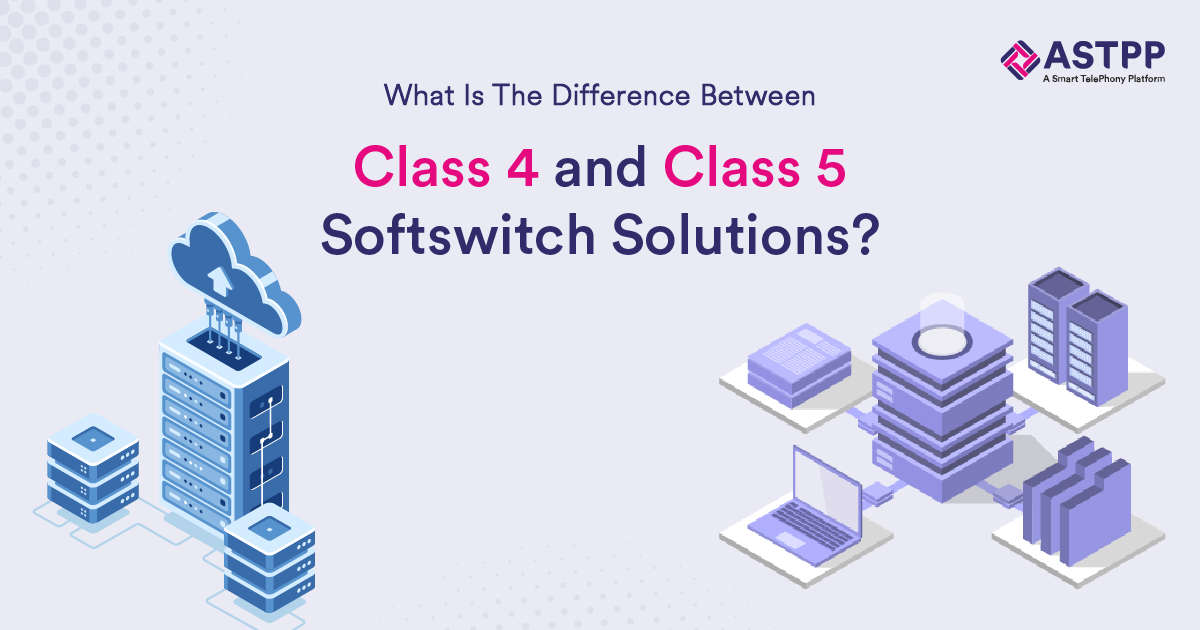Businesses prefer using VoIP based communication because of cost benefits. However, cost is not just a driving factor for all of them. Some companies prefer using VoIP based telephony solutions because of the unmatchable Quality of Service they offer. The VoIP telephony system offers advanced communication features not found in traditional systems, along with valuable enhancements for a better overall experience. There are several types of VoIP communication solutions available to empower businesses and meet their diverse needs, but two solutions have been leading the ship for many years and these solutions are class 4 Softswitch and class 5 Softswitch.
Although their roles and offerings differ, these solutions remain closely linked to deliver genuine Quality of Service (QoS) to customers.
1. What is a class 4 Softswitch solution?
It is a developed software switch enabling intelligent routing of wholesale VoIP traffic for long-distance calling. This software was originally built by an Asterisk development company to provide wholesale call routing services to offer cheap VoIP calling to businesses and even to residential users. However, the modern class 4 switch takes care of several jobs.
2. What is a class 5 Softswitch solution?
It is also a software switch, but it is developed to provide wide ranging communication and collaboration features to businesses. From voice to unified communication, Softswitch includes call transfer, recording, queues, extensions, voicemail, conferencing, and more..
3. What is the Difference Between Class 4 and Class 5 Softswitch Solutions?

Both class 4 and class 5 are VoIP based Softswitch solutions and have several common factors. These services offer affordable calls for businesses, improving call quality and features. However, they differ in several ways.
The main use of the class 4 Softswitch software is to provide a long distance call routing service to carriers. Thus, common features available in this VoIP solution are related to call routing, VoIP traffic management, etc. Moreover, this system manages massive call volume, which is why it is referred to as a wholesale Softswitch solution.
The main use of the class 5 Softswitch software is to provide retail calling services to businesses, small offices, and home offices. This software offers communication and collaboration features like CTI, internal call routing, extension dialing, off-hour call handling, voice logging, and more. This system does not manage long distance calling. It only supports retail or local calling services, which is why it is referred to as a retail Softswitch solution.
There are several differences between Class 4 and Class 5 VoIP Softswitch solutions , which we have covered in our dedicated blog on class 4 vs. class 5 Softswitch as below.
4. How do these VoIP Softswitch Solutions Manage Quality of Service?

Even if the roles of class 4 and class 5 Softswitch solutions are different, both of these solutions work in harmony to provide excellent Quality of Service (QoS) to end users. Let’s understand how.
The class 5 Softswitch software provides retail calling features to businesses. Businesses need these features, but they are not everything a business needs. Nowadays, businesses operate across borders, and they need to make long distance calls. The retail Softswitch solution cannot provide long distance calling service on its own. It has to either pass the call to the local PSTN system or the class 4 Softswitch.
For obvious reasons, the wholesale Softswitch solution is a preferred option for businesses because it provides cheap yet quality services for international calling to businesses. The class 4 Softswitch software receives call traffic from a retail switch and traverses it to the predefined destination. It then transfers the call to another switch or the PRI line to finish.
Manage VoIP Quality of Service with Our Softswitch Solutions.
This collaborative network built by class 5 and class 4 solutions helps in delivering the required quality of service. These systems create a network of VoIP telephony. The class 4 Softswitch solution makes sure that without any compatibility or security concerns, all calls get traversed to international numbers and that also without making a hole in the pocket of businesses. However, a retail switch only takes call traffic and adds various business telephony features for better service.
This way a tightly coupled network built with a class 4 along with a class 5 Softswitch solution helps in meeting business communication needs and providing affordable services with the highest quality of services.
Future trends
The VoIP companies building these Softswitch solutions are leveraging the power of other technologies to improve QoS. AI, machine learning, IoT, 5G, etc. enhance VoIP’s QoS and effectiveness.
If you are wondering whether there will be any impact of these technologies on the Softswitch systems, then you must go through one of our recent blog posts talking about the impact of artificial intelligence on the VoIP Softswitch as below.
Concluding notes
In conclusion, both solutions play roles in meeting business quality of service expectations. Distinct yet complementary, these solutions create a coupled approach meeting business QoS expectations.
A VoIP provider can use both of these solutions to serve a larger audience, but even if you use a single VoIP Softswitch, it is necessary to be aware of the role of both of them. If you are interested in buying a feature rich class 4 Softswitch and/ or class 5 Softswitch, we can help you with our futuristic solutions. To learn more about our offerings.





